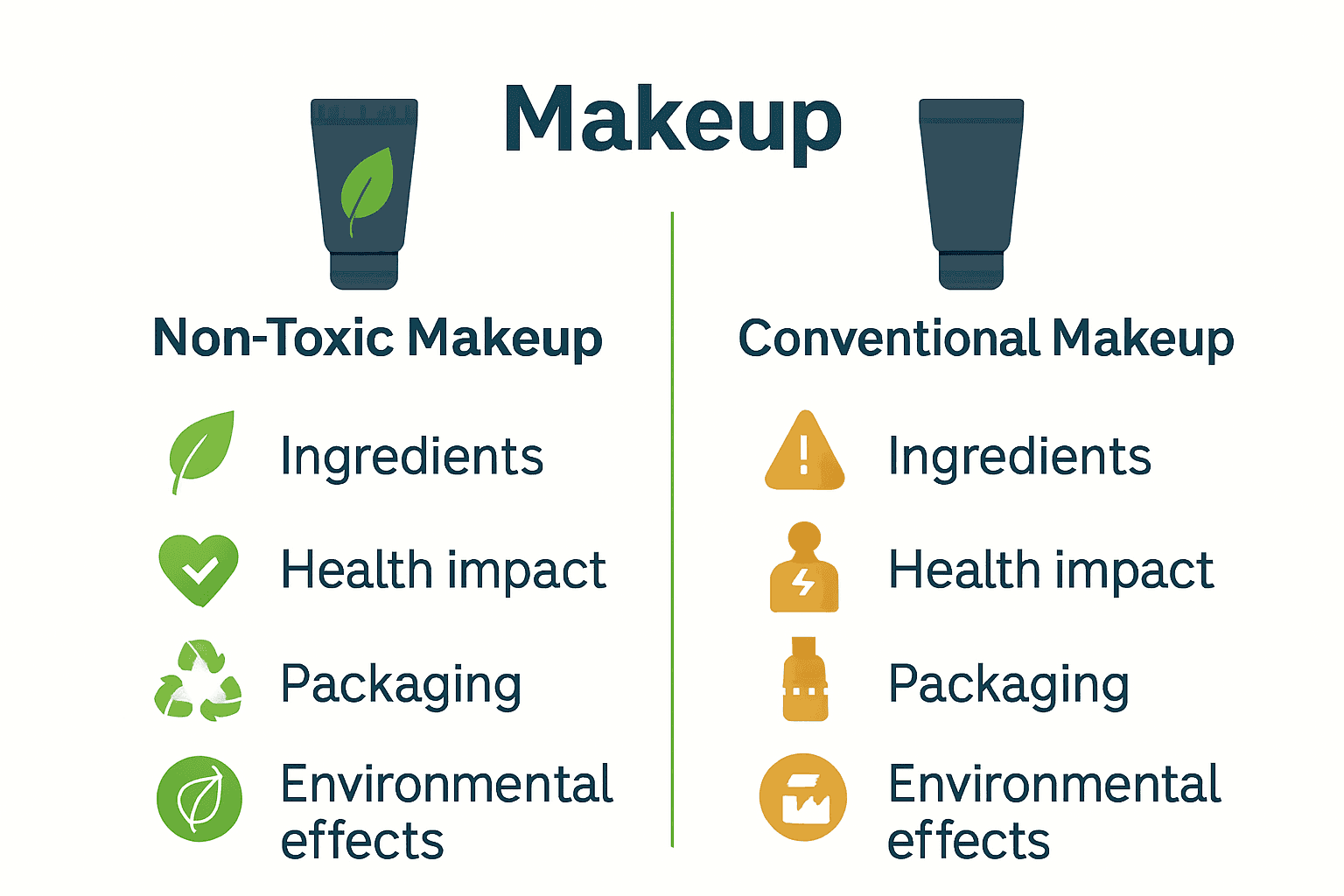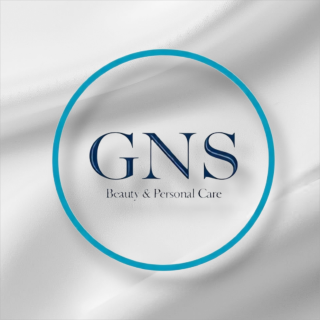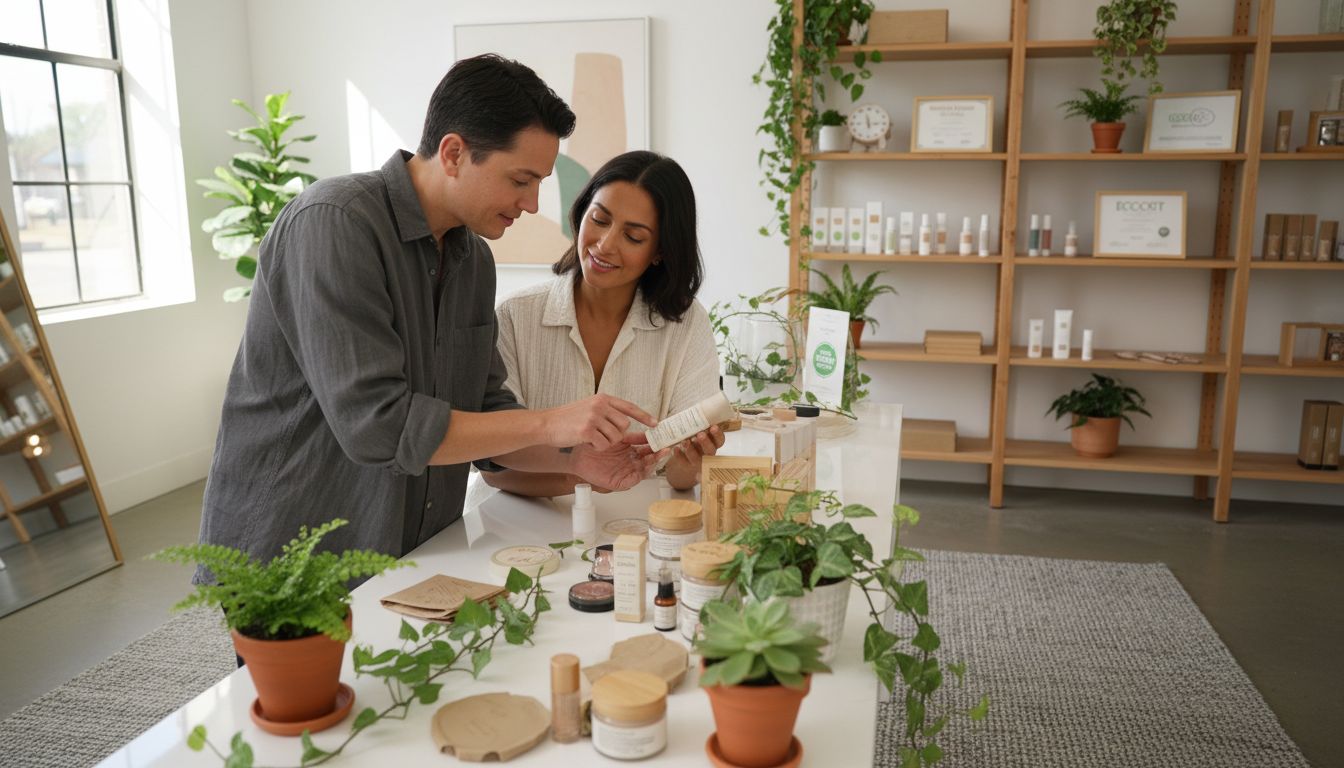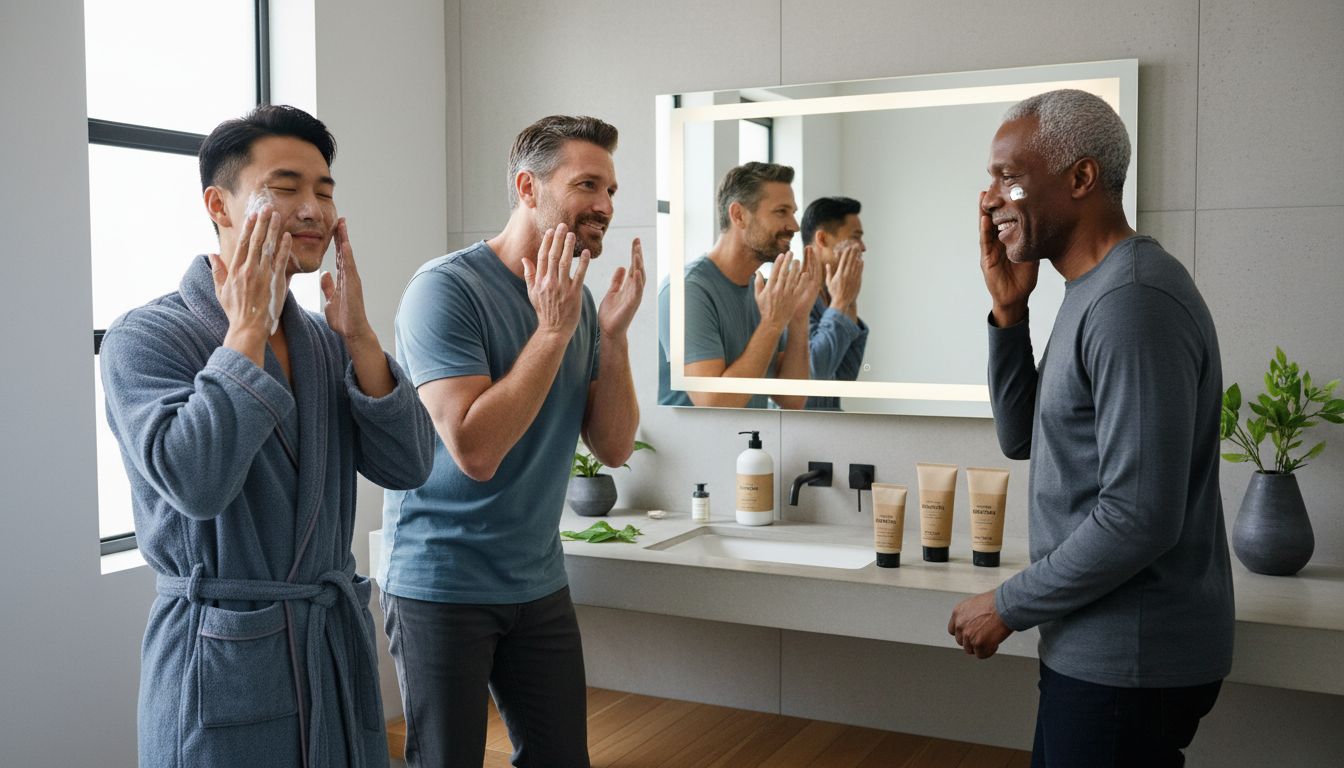Over 90 percent of american consumers use cosmetics every day, yet many are unaware of the possible dangers lurking in their makeup bags. Research shows that common beauty products often contain hazardous chemicals linked to serious health concerns. As interest in clean beauty grows, understanding what truly sets non-toxic makeup apart becomes crucial for anyone who cares about their well-being. This guide helps you make informed choices that protect both your health and the planet.
Table of Contents
- What Is Non-Toxic Makeup And Why It Matters
- Common Ingredients And Their Impact On Health
- Types Of Non-Toxic Makeup Products Explained
- Environmental And Ethical Benefits Of Non-Toxic Makeup
- Comparing Non-Toxic And Conventional Makeup Options
- How To Choose Authentic Non-Toxic Makeup Brands
Key Takeaways
| Point | Details |
|---|---|
| Non-toxic Makeup Prioritizes Health | Non-toxic makeup avoids harmful synthetic chemicals, promoting personal health and environmental sustainability. |
| Transparent and Ethical Practices | Authentic non-toxic brands commit to transparency, cruelty-free production, and sustainable ingredient sourcing. |
| Informed Consumer Choices | Understanding ingredient labels and brand claims is essential for selecting truly non-toxic products. |
| Holistic Beauty Approach | Non-toxic makeup supports long-term skin health while reducing harmful environmental impacts. |
What Is Non-Toxic Makeup and Why It Matters
Non-toxic makeup represents a revolutionary approach to personal beauty that prioritizes human health and environmental sustainability. Unlike traditional cosmetics loaded with synthetic chemicals, non-toxic makeup uses natural, safe ingredients that minimize potential health risks. According to research from LWW Journals, conventional cosmetics often contain hazardous chemicals that can cause serious long-term health complications, including potential cancer risks, reproductive toxicity, and endocrine disruption.
The core philosophy of non-toxic makeup centers on transparency and wellness. These products deliberately exclude harmful substances like parabens, phthalates, synthetic fragrances, and toxic preservatives that have been linked to significant health concerns. As documented in Frontiers in Toxicology, synthetic chemicals in traditional cosmetics can trigger a range of adverse health effects, from allergic reactions to respiratory issues and potential hormonal imbalances.
Choosing non-toxic makeup isn’t just a trend - it’s a conscious decision to protect your body’s largest organ: your skin. Here are key characteristics that define non-toxic makeup:
- Made with natural, plant-based ingredients
- Free from known harmful synthetic chemicals
- Cruelty-free and ethically produced
- Environmentally sustainable packaging
- Transparent ingredient lists
- Dermatologically tested for skin safety
By selecting non-toxic makeup, you’re making a proactive choice for personal health, supporting ethical beauty practices, and contributing to a more sustainable beauty ecosystem. Check out our guide on understanding clean beauty to dive deeper into this transformative approach to personal care.
Common Ingredients and Their Impact on Health
Toxic chemicals lurk in many conventional makeup products, posing significant health risks that most consumers are unaware of. According to research from Frontiers in Toxicology, several common cosmetic ingredients have been linked to serious health complications. These hazardous substances can silently accumulate in the body, potentially causing long-term damage to our health and well-being.
Phthalates, parabens, and volatile organic compounds represent some of the most concerning ingredients found in traditional makeup. The Guardian’s investigative analysis reveals that many beauty products contain high-hazard toxins directly linked to hormone disruption and increased cancer risks. These chemicals can penetrate the skin and accumulate in bodily tissues, creating potential health challenges that extend far beyond surface-level concerns.
Here’s a breakdown of the most problematic ingredients to watch out for:
- Phthalates: Endocrine disruptors that can interfere with hormonal balance
- Parabens: Preservatives linked to reproductive health issues
- Formaldehyde: A known carcinogenic preservative
- Synthetic Fragrances: Can trigger allergies and respiratory problems
- Triclosan: Antimicrobial chemical associated with hormonal interference
- Heavy Metals: Potential neurotoxins found in some color cosmetics
Protecting yourself starts with understanding these risks.
IMAGE:descriptive_key_1] [Learn more about clean beauty practices in our comprehensive guide and make informed choices that prioritize your health and well-being. By becoming an educated consumer, you can transform your beauty routine into a safer, more conscious approach to personal care.
Types of Non-Toxic Makeup Products Explained
Non-toxic makeup has evolved dramatically, offering a comprehensive range of products that prioritize both beauty and health. According to research from arXiv, innovative ingredients like sucrose ester surfactants are revolutionizing the cosmetics industry by providing biodegradable and non-toxic alternatives that maintain high-performance standards.
The non-toxic makeup landscape encompasses several key product categories, each designed to minimize harmful chemical exposure while delivering exceptional results. From foundations and concealers to lipsticks and eyeshadows, conscious beauty brands are reimagining traditional cosmetics with natural, skin-friendly formulations. These products leverage plant-based ingredients, mineral pigments, and advanced organic compounds to create makeup that not only looks beautiful but also supports skin health.
Here’s a comprehensive breakdown of non-toxic makeup product types:
- Foundation: Made with natural minerals, plant extracts, and hydrating botanicals
- Concealer: Formulated with organic oils and gentle covering agents
- Blush: Created using natural pigments and nourishing plant-based ingredients
- Eyeshadow: Developed with mineral colors and skin-conditioning compounds
- Lipstick: Crafted with natural waxes, organic oils, and plant-based pigments
- Mascara: Produced using natural fibers and gentle, non-irritating ingredients
Explore our guide to cruelty-free beauty brands to discover how innovative companies are leading the non-toxic makeup revolution. By choosing these thoughtfully crafted products, you’re not just enhancing your beauty - you’re making a powerful statement about personal health and environmental responsibility.
Environmental and Ethical Benefits of Non-Toxic Makeup
Non-toxic makeup represents a powerful movement towards environmental sustainability and ethical consumption. According to research from Sustainable Earth, the beauty industry is undergoing a transformative shift, with non-toxic makeup brands significantly reducing pollution and promoting more responsible manufacturing practices through eco-friendly packaging and biodegradable materials.
Research from arXiv highlights the innovative use of biodegradable surfactants, demonstrating how the beauty industry can dramatically reduce its environmental footprint. These advanced ingredients not only minimize harmful chemical exposure but also create a more sustainable production cycle that respects both human health and ecological balance. By choosing non-toxic makeup, consumers actively participate in a global movement towards more responsible and conscious beauty practices.
Key environmental and ethical benefits include:
- Reduced Chemical Pollution: Minimizing toxic chemical release into water systems
- Sustainable Packaging: Using recyclable and biodegradable materials
- Cruelty-Free Production: Eliminating animal testing and supporting ethical manufacturing
- Lower Carbon Footprint: Implementing environmentally conscious production methods
- Natural Resource Conservation: Using renewable and responsibly sourced ingredients
- Supporting Ethical Supply Chains: Prioritizing fair labor practices and sustainable sourcing
Discover more about eco-friendly beauty practices and join the movement towards a more sustainable, compassionate approach to personal care. Your beauty choices can create meaningful change - one product at a time.
Comparing Non-Toxic and Conventional Makeup Options
Conventional makeup and non-toxic alternatives represent two dramatically different approaches to personal beauty. According to research from Frontiers in Toxicology, synthetic chemicals in traditional cosmetics pose significant health risks that extend far beyond surface-level concerns. The stark contrast between these product categories reveals a critical choice for consumers seeking both aesthetic appeal and personal well-being.
The Guardian’s investigative report highlights the prevalence of high-hazard toxins in conventional beauty products, underscoring the urgent need for safer alternatives. While traditional makeup often prioritizes immediate visual results, non-toxic options focus on long-term health and skin nutrition, creating a holistic approach to beauty that goes beyond temporary cosmetic enhancement.
Key differences between non-toxic and conventional makeup include:

- Ingredient Composition: Natural, plant-based vs. synthetic chemical formulations
- Health Impact: Skin-nourishing vs. potentially harmful chemical interactions
- Environmental Footprint: Biodegradable and sustainable vs. chemical-intensive production
- Skin Sensitivity: Gentle and hypoallergenic vs. potential irritant ingredients
- Long-Term Effects: Supportive of skin health vs. potential cumulative damage
- Ethical Production: Cruelty-free and responsible vs. potentially unethical manufacturing
Explore our guide to natural makeup routines to understand how you can seamlessly transition to a safer, more conscious approach to beauty. The choice is clear: prioritize your health, your skin, and the planet with non-toxic makeup options that truly care.
How to Choose Authentic Non-Toxic Makeup Brands
Selecting authentic non-toxic makeup requires more than just reading marketing labels. According to research from Frontiers in Toxicology, consumers need comprehensive transparency in cosmetic ingredient disclosure to make truly informed choices. This means developing a critical eye and understanding beyond surface-level claims about product safety and composition.
Authentic non-toxic makeup brands distinguish themselves through rigorous ingredient standards, ethical production practices, and verifiable commitment to consumer health. These brands go beyond simple marketing rhetoric, providing detailed information about sourcing, manufacturing processes, and the specific benefits of their natural ingredients. They prioritize full ingredient transparency, third-party certifications, and demonstrable commitment to environmental and personal wellness.
Key criteria for identifying genuine non-toxic makeup brands include:
- Transparent Ingredient Lists: Complete disclosure of all product components
- Third-Party Certifications: Validated by recognized clean beauty organizations
- Cruelty-Free Verification: Confirmed animal-testing-free production
- Natural Ingredient Sourcing: Traceable, sustainable ingredient origins
- Minimal Processing: Limited chemical alterations to natural ingredients
- Environmental Commitment: Sustainable packaging and production methods
Explore our guide to clean beauty brands to discover how to navigate the complex world of non-toxic cosmetics. Your journey to safer, more conscious beauty starts with informed, intentional choices.
Discover Safe Beauty Choices That Truly Care for You and the Planet
Choosing non-toxic makeup means protecting yourself from harmful chemicals and embracing products made with natural, skin-loving ingredients. If you are ready to replace synthetic toxins with cruelty-free, environmentally friendly options that promote long-term skin health and wellness this is your moment. At GNS Beauty & Personal Care, we specialize in high-quality, sustainable personal care essentials designed to enhance your natural beauty without compromise.

Transform your self-care routine now by exploring our curated selection of non-toxic beauty products. Visit GNS Beauty & Personal Care to find everything from mineral-based foundations to organic lipsticks crafted for your health and confidence. Learn more about making conscious choices in our guide to clean beauty brands and embrace a safer, eco-friendly lifestyle with tips from understanding clean beauty. Start your journey today — because your skin and the environment deserve nothing less.
Frequently Asked Questions
What is non-toxic makeup?
Non-toxic makeup refers to cosmetics made with natural, safe ingredients that are free from harmful synthetic chemicals like parabens, phthalates, and toxic preservatives. These products prioritize human health and environmental sustainability.
Why should I switch to non-toxic makeup?
Switching to non-toxic makeup helps protect your skin from harmful chemicals linked to health issues, supports ethical beauty practices, and contributes to environmental sustainability through eco-friendly ingredients and packaging.
How can I identify authentic non-toxic makeup brands?
Look for brands with transparent ingredient lists, third-party certifications, cruelty-free verification, and a commitment to sustainable sourcing. Genuine non-toxic brands prioritize the health and wellbeing of consumers and the planet.
What are some common harmful ingredients to avoid in conventional makeup?
Common harmful ingredients include phthalates, parabens, formaldehyde, synthetic fragrances, triclosan, and heavy metals. These substances can pose serious health risks and may accumulate in the body over time.
Recommended
- Natural Makeup Routine Guide: Complete How-To Steps
- Simple Makeup for Work: Complete Application Guide
- 7 Trusted Cruelty-Free Brands for Conscious Beauty Shoppers
- Understanding Clean Beauty: A Beginner’s Guide
- Understanding Common Household Toxins and Their Impact – Omnia Radiation Balancer
- Πώς να διαβάζετε συστατικά καλλυντικών για φυσική ομορφιά - PĒLION








Hinterlasse einen Kommentar
Alle Kommentare werden vor der Veröffentlichung geprüft.
Diese Website ist durch hCaptcha geschützt und es gelten die allgemeinen Geschäftsbedingungen und Datenschutzbestimmungen von hCaptcha.